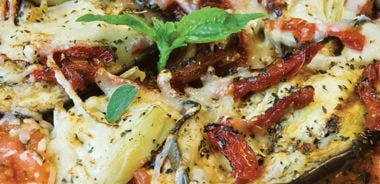Mediterranean Pizza

For the best flavour, slightly blacken the grilled eggplant.
1 completed recipe whole wheat pizza dough
1 to 2 Tbsp (15 to 30 mL) cornmeal
1/4 cup (60 mL) bruschetta
1/4 tsp (1 mL) dried basil
1/4 tsp (1 mL) dried oregano
2 cooked, canned artichoke hearts, sliced thinly
6 sun-dried tomatoes packed in oil, sliced thinly
1 small eggplant, sliced thinly, grilled
3 oz (75 g) mozzarella cheese, grated
1 oz (30 g) Asiago cheese, grated
Preheat oven to 450 F (220 C). If using a pizza stone, place on the middle rack and let preheat for 1 hour. If using a regular pizza pan, preheat oven.
Shape and stretch dough into a 12 in (30 cm) circle. Sprinkle counter with cornmeal. Place circle of dough on top of cornmeal; press down lightly; shake off excess and transfer to either baker’s peel or pizza pan.
Spread bruschetta evenly over top. Sprinkle with basil and oregano. Evenly scatter artichoke hearts, sun-dried tomatoes, eggplant, and both cheeses over top.
Carefully slide onto pizza stone. If it sticks, use a flipper to loosen an edge and then slide onto stone. Alternately, place pizza onto pan and into oven.
Bake for 12 to 15 minutes or until crust is golden brown. Using baker’s peel, slide pizza off the stone or remove pizza pan. Place onto chopping board and cut into equal slices.
Tip: Want to reduce your fat intake? Choose low-fat cheese.
Makes 8 slices.
One slice contains:
210 calories; 8.9 g protein; 6.3 g total fat (2.3 g sat. fat, 0 g trans fat); 29.5 g carbohydrates; 7.3 g fibre; 303 mg sodium
source: "Homemade and Wholesome Pizza", alive #329, March 2010




